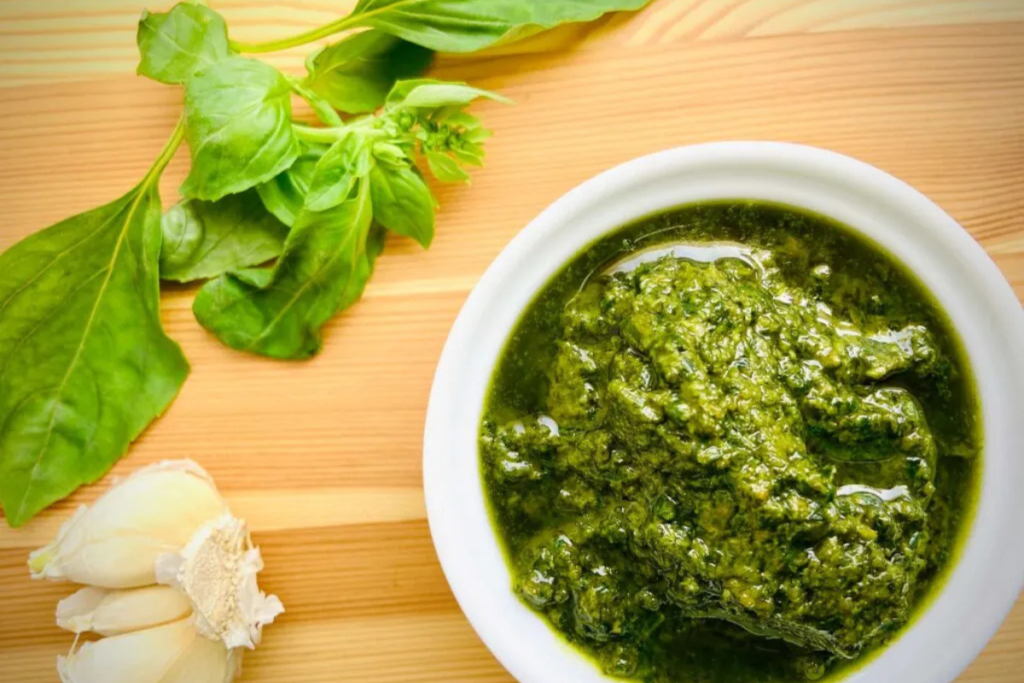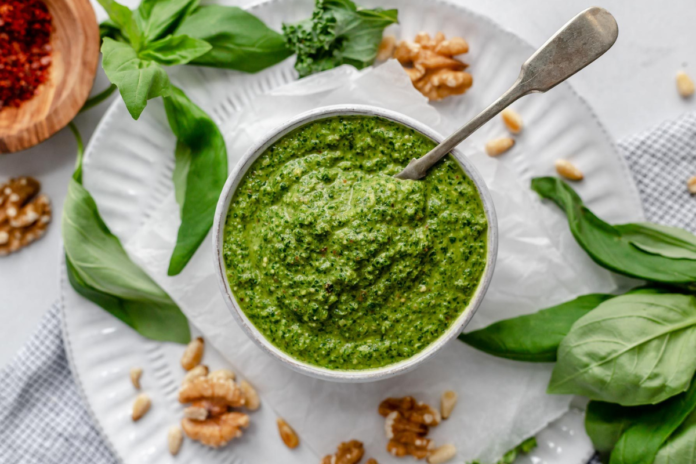Pesto is a traditional Italian sauce that has gained popularity all over the world due to its delicious taste and versatility. Made with fresh herbs, nuts, olive oil, and Parmesan cheese, pesto is not only a flavorful addition to dishes but also packs a powerful punch of health benefits.
In recent years, pesto has been hailed as a super-food sauce due to its nutritious ingredients that provide numerous health benefits.
From boosting our immune system to improving heart health, there’s no doubt that pesto is more than just a tasty condiment. In this article, we will explore the various health benefits of this humble yet mighty sauce and how you can easily incorporate it into your diet for maximum health benefits.
What Is Pesto?
Pesto is a thick, green sauce that originated in Genoa, Italy. The word “pesto” comes from the Italian word “pestare,” which means to pound or crush. The power of pesto, a super-food sauce for health, is evident in how traditionally, pesto was made by crushing all the ingredients together with a mortar and pestle.
Today, there are various versions of pesto available, but the classic recipe typically includes fresh basil leaves, pine nuts (or other nuts like walnuts or almonds), garlic, olive oil, and Parmesan cheese. Also, some modern versions may include additional ingredients like spinach, kale, or sun-dried tomatoes.
Pesto is usually served with pasta dishes but can also be used as a marinade for meats, fish, and vegetables. It’s known for its rich and savory taste that adds depth to any dish it’s added to.
The Health Benefits of Pesto

As mentioned earlier, pesto is more than just a delicious sauce; it’s also packed with essential nutrients that provide numerous health benefits. Here are some of the top health benefits of pesto:
Rich in Antioxidants
Pesto is loaded with antioxidants, primarily due to its basil and garlic components. Antioxidants are vital because they neutralize free radicals in the body, reducing oxidative stress and lowering the risk of chronic diseases.
Basil, one of the key ingredients in pesto, is rich in a variety of phenolic compounds known for their strong antioxidant properties. Moreover, garlic adds another layer of powerful antioxidants such as allicin, known to combat harmful oxidative agents in the body.
Together, these ingredients make pesto a potent source of antioxidants, potentially freeing the body from oxidative damage that can lead to conditions such as heart disease and cancer. Regular consumption of antioxidant-rich foods like pesto can contribute to better overall health and longevity, making it a flavorful yet beneficial addition to one’s diet.
Boosts Immune System
Another benefit of pesto’s antioxidant content is its ability to boost the immune system. Antioxidants help support the body’s defense against illness and infection by protecting cells from damage caused by free radicals.
Furthermore, basil in pesto contains antibacterial and antiviral properties that can aid in fighting off bacteria and viruses. With a strong immune system, one can better ward off common illnesses like colds, flu, and other infections.
Plus, the vitamin C content in basil and garlic also contributes to a stronger immune system. Vitamin C is known for its ability to enhance the production of white blood cells, which play a crucial role in fighting off infections.
Good for Heart Health
Pesto contains heart-healthy ingredients like olive oil and pine nuts that make it an excellent addition to any diet aiming to improve cardiovascular health.
Olive oil, a staple in pesto recipes, is rich in monounsaturated fats that can help lower LDL (bad) cholesterol levels and reduce the risk of heart disease. Additionally, pine nuts are packed with healthy fatty acids that can help decrease blood pressure and promote better heart health.
Moreover, pesto’s garlic content may also contribute to improved heart health. Garlic has been shown to lower blood pressure, cholesterol levels, and reduce the risk of heart disease.
Anti-Inflammatory Properties
Chronic inflammation in the body is linked to various diseases such as arthritis, cancer, and heart disease. However, pesto’s ingredients like basil and olive oil contain compounds known for their anti-inflammatory properties.
Basil contains essential oils that have anti-inflammatory effects on the body, and olive oil contains oleocanthal, a compound that works similarly to ibuprofen in reducing inflammation.
By including pesto in your diet regularly, you can potentially reduce chronic inflammation in the body and improve overall health.
May Aid in Weight Loss
Pesto’s ingredients are not only beneficial for overall health but may also aid in weight loss efforts.
The monounsaturated fats in olive oil and pine nuts have been linked to increased satiety, meaning they can help you feel full for longer periods, reducing the temptation to overeat. Additionally, pesto is lower in calories compared to other sauces like cream-based or butter-based ones.
Source of Vitamins and Minerals
Lastly, pesto is a great source of vitamins and minerals that contribute to optimal health. Basil is packed with vitamin K, which is essential for bone health and blood clotting. Additionally, it contains iron and calcium, necessary for healthy bones and muscle function.
Pine nuts are rich in magnesium, a mineral that plays a role in various bodily functions such as regulating blood pressure and maintaining nerve and muscle function.
Moreover, pesto’s garlic content adds to its vitamin C content, making it a good source of this immune-boosting vitamin.
How to Incorporate Pesto into Your Diet
Now that we know how beneficial pesto can be for our health, the next question is – how can we incorporate it into our diet?
Thankfully, there are numerous ways to add pesto to your meals without much effort.
- Pasta dishes: The most classic way to enjoy pesto is by tossing it with cooked pasta for a quick and delicious meal. Plus, you can add other ingredients like chicken, shrimp, or roasted vegetables for added nutrition and flavor.
- Sandwich spreads: Pesto makes a great spread for sandwiches, adding a burst of flavor to your usual lunchtime fare. You can also mix it with mayonnaise for a creamy and flavorful sandwich spread.
- Marinades: Use pesto as a marinade for meats, fish, or vegetables before grilling or roasting them. The herbs and garlic in the sauce will infuse into the food during cooking, enhancing its taste.
- Pizza topping: Instead of traditional tomato sauce, try using pesto as the base for your homemade pizza. It adds a unique and delicious flavor that pairs well with various toppings.
Ultimately, the options are endless when it comes to incorporating pesto into your meals. Get creative and experiment with different dishes to find your favorite way to enjoy this versatile sauce. Your taste buds and health will thank you!
How to Make Pesto at Home

While store-bought pesto is convenient, making it at home allows you to control the ingredients and ensure freshness. Here’s a simple recipe for homemade pesto:
Ingredients:
- 2 cups fresh basil leaves
- 1/2 cup pine nuts (or walnuts)
- 1/2 cup grated Parmesan cheese
- 3 cloves garlic, minced
- 1/4 tsp salt
- 1/4 tsp black pepper
- 1/2 cup extra-virgin olive oil
Instructions:
- In a food processor or blender, combine the basil, pine nuts, Parmesan cheese, garlic, salt, and pepper. Pulse until well combined.
- While the blender is running, slowly pour in the olive oil until the pesto reaches your desired consistency.
- Store in an airtight container in the fridge for up to a week or freeze for longer storage.
Enjoy freshly made pesto with your favorite dishes anytime!
Who Does Not Benefit from Pesto?
While pesto has numerous health benefits, some individuals may not benefit as much from consuming it. For example, people with nut allergies should avoid pine nuts and use an alternative like walnuts instead.
Moreover, those with lactose intolerance or following a vegan diet should choose a dairy-free option for the cheese component in pesto recipes.
Plus, people with sensitivities to garlic may experience adverse effects from consuming pesto due to its high garlic content. It is always best to consult with a healthcare professional before making significant changes to your diet. They can advise if pesto is suitable for you and suggest alternatives if needed.
How Much Pesto Should You Consume?
Like with any food, moderation is key when it comes to pesto. While it contains beneficial ingredients, it is also high in calories and fat due to its olive oil and cheese content.
As a general guideline, aim for 1-2 tablespoons of pesto per serving or meal. This amount provides enough flavor without adding excessive calories.
Also, be mindful of the other ingredients you are using in your dish. For example, if you make a pasta dish with pesto and top it with additional cheese, the overall calorie and fat content will increase significantly.
Mistakes to Avoid When Using Pesto

Here are some common mistakes to avoid when using pesto in your cooking:
- Adding pesto to hot dishes too early: Since pesto is made with fresh ingredients, adding it to a hot dish too early can cause it to lose its vibrant color and flavor. It’s best to add it towards the end of cooking or use it as a finishing touch.
- Using too much pesto: As mentioned earlier, moderation is key when it comes to consuming pesto. Using too much of it in a dish can overpower the other flavors and make it overly rich.
- Not adjusting for salt content: Pesto typically contains some salt from the cheese and salt used in the recipe. Be mindful of this when adding additional salt to your dishes that already include pesto.
- Not storing it properly: While homemade pesto can last in the fridge for up to a week, be sure to store it in an airtight container and cover the top with olive oil to prevent it from browning.
By following these tips and tricks, you can enjoy all the benefits of pesto without any drawbacks. So go ahead and add some pesto to your next meal – your taste buds and health will thank you!
FAQs
How can pesto be considered a superfood sauce for health?
Pesto is considered a superfood sauce for health due to its nutritious ingredients like good quality olive oil and roasted nuts. Adding pumpkin seeds to a classic pesto can further enhance its nutritional profile, making it a great addition to healthy recipes.
What role does good quality olive oil play in making pesto healthy?
Good quality olive oil is crucial in making pesto healthy as it provides healthy fats and antioxidants. This ingredient not only enhances the flavor of the pesto recipe but also contributes to overall wellness, making it a staple in superfood pesto.
How can you incorporate superfood pesto into simple healthy recipes?
Superfood pesto can be easily incorporated into simple healthy recipes by pairing it with zucchini noodles or spreading it over roasted vegetables. These dishes are nutritious and delicious, showcasing the versatility of pesto in various healthy meal options.
Why might nutritional yeast be used in a pesto recipe?
Nutritional yeast can be used in a pesto recipe to add a cheesy flavor without dairy, making it an excellent option for those seeking a plant-based alternative. It complements the other ingredients like roasted nuts and pumpkin seeds, enhancing the overall taste and health benefits of the pesto.
Conclusion
In conclusion, pesto is a delicious and versatile sauce that can add flavor and nutrition to a variety of dishes. It is rich in vitamins, minerals, and healthy fats, making it a great addition to any well-balanced diet.
Whether you use store-bought or homemade pesto, be mindful of the ingredients used and consume it in moderation. Plus with the step-by-step guide on how to make pesto at home, you can customize it to your liking and enjoy its fresh taste anytime.
So next time you’re looking for a flavorful sauce or dressing, reach for the pesto and elevate your meals in a healthy and delicious way. Bon appétit!




